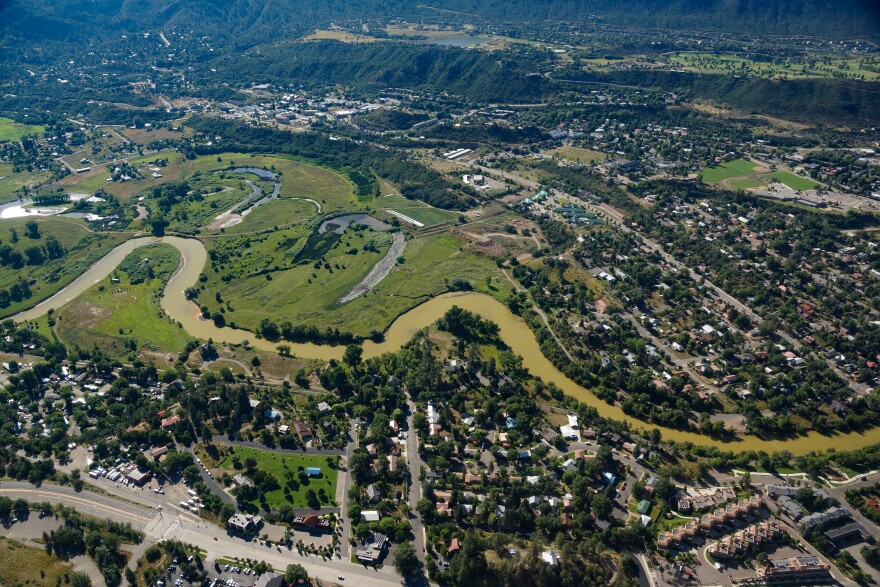There are differing opinions about whether a Gold King mine disaster could happen in Aspen’s backyard. The spill, accidentally triggered by an Environmental Protection Agency team, let loose 3 million gallons of contaminated water into the Animas River in southwest Colorado. Aspen Public Radio’s Marci Krivonen explored whether such a catastrophe could happen here.
The spill turned the Animas bright orange and halted river access in an area known for rafting.
Businesses reliant on the river aren’t the only casualties - communities that pull drinking water have shut off connections. The plume has moved downstream into New Mexico and Utah and will eventually reach Lake Powell.
When Aspen pilot Bruce Gordon saw it Sunday, the brilliant color was fading.
"By that time the plume was down near Farmington, near the New Mexico border," he says. "The remnants and the sediment on the edges of the river were very pronounced, but nothing was as vivid as the original photographs where we saw the kayakers in what looked like yellow finger paint."

The release happened Wednesday. An EPA team was working to install a concrete plug in an inactive mine when a dam broke and spewed wastewater into a tributary of the Animas.
"It was a terrible tragedy and inadvertent accident," says Bruce Stover. "The goal of the project was to prevent what happened from happening."
Stover is director of the Colorado Inactive Mine Reclamation Program. There are more than 20,000 abandoned mines in the state. Six hundred of them are in Pitkin County.
"We’re not aware of any issues similar to what happened last week in San Juan County, in Pitkin County," says Stover.
He says water that collects in unused mines on Aspen Mountain drains, so water doesn’t build up in pools like it did at Gold King. Still….
"There could be some other smaller mines here and there in Pitkin County that might have a discharge. Any inactive and abandoned mine unattended and not inspected and no one’s underground, you can always have a cave-in or roof collapse that traps the water that’s normally flowing and if the pressure builds up enough, you can get these things to surge and blow out."
In mining lingo, it’s called a “hiccup” and it’s possible in Pitkin County. But, Stover says a disaster of the magnitude seen on the Animas is unlikely. Pitkin County Commissioner Patti Clapper agrees.
"It’s not that we don’t have mine concerns here - we have mineshaft concerns, we have mine tailings concerns here, but nothing to the extent they have in that part of the state," she says.
The state has blocked public access to 80 hazardous abandoned mines in Pitkin County and reclaimed 350 acres of mining disturbed property, like piles of tailings.
In the 1980s Clapper got involved with the EPA that labeled Smuggler Mountain a superfund site. An analysis at the time showed high levels of toxic metals in soil, but the Roaring Fork River wasn’t contaminated.
"We tested to be the cleanest community in the country for blood-lead levels in our children because of the mining process that was not used here and because of the makeup of our geology," says Clapper.
Reporter: "Do you have any idea whether something like this could happen in this region?"
Mark Williams: "We have something like 23,000 abandoned mines in the state of Colorado."
Mark Williams is a professor of geography at CU-Boulder.
"Almost all of them are at high elevation, in steep mountain areas," he says. "Most of those have cave-ins, so the chance of a pool forming is high. So a catastrophic release? Yeah, the chances are high that it could happen in Aspen or anywhere else in the state.”
He’s working with the EPA on a mine near Creed, where millions of gallons of toxic water have collected. If released, he says it would be an even bigger disaster than Gold King.
In Durango Tuesday, Governor Hickenlooper predicted river recreation would return within a week.
"We want to take no risks, but we want to get everybody back to the river they love as quickly as possible."
The appearance of the Animas may be the worst part. Again, governor Hickenlooper.
"I am very confident there will be no long-term ill effects. We’ve had runoffs of high heavy metals before that washed through. We’re testing the fish and the water. If there’s any problem, we’ll take care of it."
His visit to the affected area followed a disaster declaration from his office earlier in the week. Meanwhile, the Colorado Department of Public Health reports initial tests on the Animas River show the concentration of contaminants continues to decrease.
Colorado Public Radio helped in the reporting of this story.


